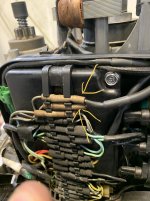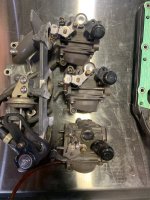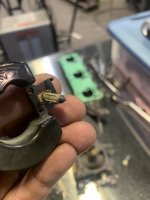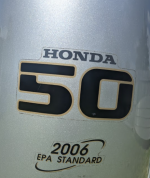Newbie sailor
Seaman Apprentice
- Joined
- May 6, 2021
- Messages
- 31
This is crossposted and hoping to get a little more help.
I was handed down a sailboat with the BF50 sitting for around 5-7 years. Upon first start up, new non ethanol fuel, hose hooked up. Motor ran but started leaking from carb 1 dust cap. Other forums pointed me to a stuck float. Didn’t run it after that.
Took the carbs apart, cleaned in sea foam, checked float and needle float in a sink of water, they looked good and floated, no cracks. I reinstalled carbs with new gaskets and O-rings.
I started her up, still leaks from Carb 1 dust cap. But while in there I ran it a little longer and noticed cylinder 1 was not firing (I put new plugs in). Cylinder 2 and 3 had burnt fuel on them. The kicker: while running I can unplug spark plug wires 1 and 2 and motor runs with no difference. Unplug 3 motor dies.
This tells me the motor is running on cylinder number 3.
So the stage I’m at now. I’ve taken apart the leaking carb and currently recleaning it and checking float.
Questions:
Does carb 1 not firing have anything to to do with it leaking?
I’ll be posting a picture of the coil which looks to be burned.
Advice and help?
I was handed down a sailboat with the BF50 sitting for around 5-7 years. Upon first start up, new non ethanol fuel, hose hooked up. Motor ran but started leaking from carb 1 dust cap. Other forums pointed me to a stuck float. Didn’t run it after that.
Took the carbs apart, cleaned in sea foam, checked float and needle float in a sink of water, they looked good and floated, no cracks. I reinstalled carbs with new gaskets and O-rings.
I started her up, still leaks from Carb 1 dust cap. But while in there I ran it a little longer and noticed cylinder 1 was not firing (I put new plugs in). Cylinder 2 and 3 had burnt fuel on them. The kicker: while running I can unplug spark plug wires 1 and 2 and motor runs with no difference. Unplug 3 motor dies.
This tells me the motor is running on cylinder number 3.
So the stage I’m at now. I’ve taken apart the leaking carb and currently recleaning it and checking float.
Questions:
Does carb 1 not firing have anything to to do with it leaking?
I’ll be posting a picture of the coil which looks to be burned.
Advice and help?
























